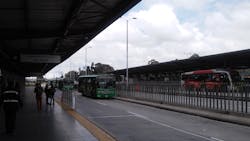At any given time of day, Portal El Dorado in Bogota, Colombia, is a shining example of why the city’s famed Transmilenio bus rapid transit system is considered one of the most successful projects of its kind.
Three platforms straddle six different sets of lanes along Avendia El Dorado. Outside of the western platform, car traffic slowly chugs along, with riders on small motorcycles weaving precariously between lanes to get past the traffic jam. Inside the platform, blue and green buses pull up in droves and drop off hundreds of riders, who quickly disembark, run to a ramp taking them underneath station and into the center platform where a line of red Mercedes, Scania and Volvo buses pull in on each side and pick up hundreds of passengers. Another rider apparently fearing missing his bus jumps off the platform, darts across four lanes of traffic and in front of a Volvo double articulated bus with nearly 300 people on board, jumps the bollards in order to get to the other side and the green feeder buses.
A similar scene takes place on the eastern platform while auto traffic crawls in the other direction. The constant honking of horns and acrid smell of diesel lingering in the air from the surrounding traffic is the only thing the Transmilenio riders share in common with the drivers as their buses fly through town as the cars crawl.
Meanwhile bicycles whiz through a bicycle corridor running down the center of the BRT corridor and underneath El Dorado station. A bicycle storage area free of use at for all passengers who register their names, bikes and fingerprints is brimming with hundreds of bicycles from commuters who took their first mile via bike to the station.
“In Bogota, 7 percent of the trips we make daily are made on bicycle,” said Carlos Alberto Acosta Rada, profesional especializado negocios colaterales subgerencia de desarrollo de negocios, Transmilenio. “We have to take into account everything and how to integrate all these as a backbone of the city.”
Portal El Dorado is one of the head stations of the Transmilenio and sees about 80,000 passengers per day pass through its turnstiles. While successful, it’s too successful and now Bogota is trying to find a way to create its mobility future and find a way to use transportation to not only make the city a economic leader in Latin America, but a world-class economic powerhouse.
When the BRT was built, it was designed to handle about 1.3 million people per day. It’s success has 2.4 million people crowding on daily, Acosta said, as another 1.2 million use the feeder buses.
Getting so successful wasn’t an easy feat.
“We have a lot of errors,” Acosta said. “We had to get rid of things and adjust for the movement of the city.”
Acosta said Transmilenio learned double lanes were needed at each station so the left lane allowed for one bus to stop while other limited route buses could pass by in the right lane. It allows to increase the capacity of the system by 50,000 per space per hour.
“It has much more capacity than many metro lines in the world,” he said.
Fare on Transmilenio is 1,800 Colombian Pesos, which is about 65 cents. The government is forbidden from giving subsidies to the operations of the transit agency, so Acosta said they have to account for all service using the fare and demands on the system.
“We know the behaviors of how people move in this city,” he said.
Bogota is a lot like North American cities. The majority of riders commute in from the outskirts of town into the center for work and then back in the afternoon. Because of this, Transmilenio offers free bicycle parking at all of head stations. There are 2,800 bicycle parking spots in Transmilenio, where riders bring in their bike, which are scanned, then the person is fingerprinted and their photo ID is on file. Their bike sits unlocked all day, but when they pick it up, guards at the station must again fingerprint and scan the bicycle in order to prevent theft.
Using the BRT model allowed for Bogota to get more efficient with transit, When Transmilenio started 15 years ago, the city had 25,000 buses in the streets. Right now there are 11,000, with the agency’s goal of being at 12,500 buses to supply the 160 different types of bus service offered by the agency.
The agency works with various contractors for all of the lines. For the blue buses there are nine contractors alone. When the contractor takes control of a line they’re ordered to destroy all the old buses.
“It’s a political decision,” Acosta said of the rule.
GPS systems and fleet management systems from Etra and Goal Systems track buses and driver behavior to make sure the contractors are meeting their performance goals are being met. Acosta said drivers make about $1,500 per month, which is considered a good wage in Colombia and contractors must follow labor rules in the contracts.
In the event of an emergency, operators can contact dispatch, but there are no cameras on buses. Acosta said they want them, but when asked why they’re not on board, he simply rubbed his fingers together to symbolize the cost prohibitions.
“There are a lot of thieves these days in the city but no cameras,” he said. “It costs a lot.”
There are cameras across the system and Acosta said Transmilenio sends staff along the BRT route on motorcycles to look for issues along the way. Dispatchers — who each communicate with 120 to 150 buses at a time — relay information with drivers in the field.
The BRT corridor is the only area of the city often clear given the city’s massive congestion issues. It’s a steep $800 fine if someone is caught driving in the dedicated lanes. It also means Transmilenio has to coordinate with other parts of the government when big movements take place.
“When the president must go to the airport, they must coordinate with us,” he said. “Or when we have to send drug traffickers to the United States, they must coordinate with us.”
As built today, Acosta said the BRT costs about $2.5 billion. Another 35km is planned in the coming years to expand further.
Not Bogota of Old
Bogota is a city looking to transform how it moves and what it looks like and transportation infrastructure plays a key part in the city’s transformation.
Juan Carlos Jimenes, investment promotion manager for Go Bogota, a non-profit entity created in a venture between the city and local chamber of commerce to promote foreign investment in Bogota, said the city constantly ranks high in places to do business in Latin America and has one of the best ranked strategies for doing business in the world. There is a young and educated workforce in Bogota, with 100,000 graduates coming out of the city every year and a working population of about 4.5 million.
Since 2002, the country has seen its poverty rate drop from 50 percent to 28 percent, while the middle class shot up from 16 percent to 31 percent. By 2025, 45 percent of the population is projected to be in the middle class.
With a population of 7.7 million and a metro population of 10.5 million, Bogota is also one of the largest cities in the world without rail transit.
The creation of an underground metro system has long been discussed in Bogota, but not much progress has been done until the past several years. In 2014, the city closed the basic engineering studies for the metro, with the plans for the national government to cover about 70 percent of the construction cost of the roughly $6 billion 27km fully underground system with the other 30 percent
coming from credit from the city.
However, former mayor Gustavo Petro Urrego, who supported the fully underground metro lost in the November election to Enrique Peñalosa Londoño, who created Transmilenio when he was first mayor in the 1990s, which has created doubt on the potential makeup of the metro.
“If all goes well and we can have a commitment from the local and national government…we should have some sort of tenuring process by the end of next year, with construction the following year,” Jimenes said. “Then we will have something that would carry 600,000 to 800,000 passengers per day to reduce some of the influx into the transit system we have today.”
Jimenes said the organization has been working directly with the Institute for Transportation Development (IDU) to organize some of the information available and to study similar cases in places like Mexico City and Lima, Peru, to formulate possible scenarios and best practices in building and operating a metro system.
Jimenes said they also met with Transport for London (TfL) to look at some possibilities and what Bogota needs.
“It’s crucial for a city of our size to continue to keep growing to what we’re expecting in the next 10-20 years we’re going to need more than just the buses,” he said.
Besides the first line, Jimenes said there are several other lines being studied mostly running north to south to connect the city and tackle some of the largest traffic volumes that happen each day.
“In terms of urban renewal, there’s lots for us to do. Social housing is always a big challenge.” Jimenes said. “But one of the biggest complaints about Bogota is mobility, it’s not easy to get around. It’s not large in terms of geographic expansion…but moving around here is a challenge.”
Bogota is also investing cable cars to build connectivity in the city’s poorer neighborhoods in the high mountains. Right now it takes about 90 minutes for residents of the area to commute about 3.5 km. When the cable cars are completed, that commute will be shed to 15 minutes.
“It’s about social mobility,” Jimenes said.
Rail is part of Bogota’s history, but it hasn’t had a place in the past 50 years.
Jose Alejandro Echeverry Carbonell, profesional especializado de transporte, Subgerencia Técnica y de Servicios, said at the end of the 19th Century, Bogota had built its first tram lines and had several intercity passenger rail lines. However, about 50 years ago, the government decided to only finance car-centric development and the infrastructure went into decay though corridors still stands today.
“Today you can’t go anywhere by just buying a ticket to another city,” he said. “But the infrastructure still exists.”
The tram system was electrified in the 1920s, but in the April 9, 1948 riots known as Bogotazo after popular presidential candidate Jorge Eliécer Gaitán was assassinated, half of the city was burnt down and the entire tram system was completely destroyed. By 1951, the system was completely shut down and cars ruled the city despite tramway tracks still sitting above ground around the city.
“The city transport was left in the hands of a few mercenaries, or privateers,” Carbonell said. “It was a very hard situation. They had transport permits, but we really unregulated and did anything they wanted. The only thing they did abide by was the tariff that the city established for what they charge.”
Carbonell said there are plans to connect Bogota with the rest of the country via rail using the reserved corridors, but completely new infrastructure is needed. Current tracks still use yard gage track from the era of steam locomotives.
“What we have is 100 years old basically,” he said.
“The long-term goal is to connect the whole country, but since we basically have no passenger trains right now, our goal is for like 40 km outside of Bogota,” Carbonell said. “After that we’ll see what happens.”
Despite the country’s economic growth and demand for better transportation, the current infrastructure doesn’t meet the needs of Bogota or Colombia. Jimenes said Colomia is rated one of the worst in transportation infrastructure, rated near Haiti and Bolivia. To fix this, the government is focusing on a $25 billion investment in roadways, railways and waterways so it can compete economically.
To build transit infrastructure, value capture projects play a key role in the city’s future. One plan calls for the creation of an underground station for the Transmilenio station that connects three lines of the BRT, with several residential and commercial towers built ontop of the station. The planned metro system would also come nearby the station along with the planned regional tram line.
The city started purchasing land for the station in 2004 Carbonell said, with the investment of the towers being mostly private via a public-private partnership (P3).
More massive plans are set throughout the city to create value capture property, but when they will become fruition is still unknown.
“Some will see the light of day, some who knows,” Carbonell said. “But the ambition is important.”
FITRANS
Because of the city’s ambitions, the biannual Feria Internacional de Transporte Corferias (FITRANS), is a major showcase for companies coming into the market and connect with the ambitious state and local leadership. The 2015 show took place Nov. 18-21.
“It’s a specialized event where we wanted to get together as many elements and sectors within the transportation sectors and all the stakeholders around massive transport and commercial transport under one roof to share ideas and business opportunities,” Carbonell said. “We basically have everyone together involved in the transport sector.”
The show was expected to bring in about 6,000 attendees and 63 vendors to the Corferias de Bogota as they came to see session from worldwide experts on transportation issues and the latest clean technologies made available across the world. Organized by Bogota’s Transmilenio transit system, Fenalco and Conferias Bogota, FITRANS is Colombia’s largest transportation show.
Carbonell said the three main axis of the show are transit-oriented development, emerging technologies and sustainable transport for everyone.
“This is basically helping us in understanding what’s going on in the world,” he said. “we know that there are a lot of cities in Europe that have vast experience with hydrogen buses. China has also had some interesting experiences with hydrogen., We want to share all these experiences, to see where the world is going, where we’re going to go and how this can help with public health and climate change problems today.”
Companies with a wide footprint already in the North American transit market, such as Allison Transmission, Voith Turbo, Volvo Bus, BYD, Hanover Displays and Whiting Systems presented products into the showcase as they work to grow their presence in the Latin American Market. The show was merged with the Mercani-k 2015 show, which featured maintenance equipment for light and heavy-duty applications and featured a demonstration of bus mechanical skills by a group of technicians at the fairground.
Volvo Bus — which is the largest provider of buses to Transmilenio — displayed its latest articulated hybrid bus to the market that meets Euro 6 emissions standards. Most systems across Latin America use Euro 1-3 equipment on roads, however cities like Bogota are looking to increase their fleets to Euro 5 or 6 standards in order to improve air quality and public health.
Renan Schepanski, sales engineer for Volvo Buses Latin America, said the bus at the show is getting tested in Curitiba, Brazil in coming weeks and the company is positioning to help South American cities get to pure electric buses as well.
Volvo is looking to fit the buses with pantograph systems for fast charging capabilities along routes. He said the company has worked with Siemens and ABB on the technology in Europe and will work exclusively with ABB in South America to develop a charging system for the market.
“Basically this bus here, the only next step is electric,” Schepanski said of the standard. “It’s basically impossible after this to produce cleaner emissions without being electric.
Transmilenio is looking to hybrid, natural gas and pure electric buses to clean its fleet in coming years, so Scania showcased a natural gas bus and BYD showed its articulated pure electric bus it plans to test in the bus rapid transit system in coming months.
Chinese bus manufacturer Higer is entering the Latin American market and showcased its hybrid bus that uses a combination of a Cummins diesel engine and Siemens hybrid system. Alan Ma, gerente for Higer, said the company tested the bus with a Colombian University recently and has seen positive results.
“There’s a lot of interest and it’s a system that works,” Ma said.
The quest for cleaner air in Latin America was a focus of sessions at the FITRANS congress where speakers such as Robin Chase, founder of Zipcar, and Kathryn Urquhart, of C40 Networks. The congress started off on a fiery note as outgoing Bogota Mayor Gustavo Petro Urrego directed challenges to Colombian national officials on the crowd about the national priorities of the country in cleaning the environment and improving public health when the state still invests in fossil fuels questioning the investment in “quick money in exchange for killing children.”
Transit-oriented development is also a hot topic at FITRANS as Bogota explores value capture projects to fund expansion of Transmilenio and the possible building of a metro system. Urban development specialist Hiroaki Suzuki spoke on the topic Nov. 20.
Carbonell said there is a debate in Colombia now on how to fund transit services in the country even though it’s currently illegal to provide an operating subsidy to keep them moving. Cities like Paris have a 60 percent subsidy of the transit system while Hong Kong can operate without one and looking at the two different models is creating different ideas of what the future will be.
Carbonell said Transmilenio was self-sustaining from inception until 2009, but the complexity of the growing demand makes it more expensive to operate.
“When the system was born, it was created a self-sustainable, but the reality shows that in order to be self-sustaining, we have to sacrifice quality of the service,” he said.
“Part of the success of our system is its complexity,” Carbonell said. “Some people look at it and say ‘wow, this is much too complex for me to understand,’ but at the same time, that complexity makes it able to move as many buses as we can."
The initial Transmilenio corridor on Caracas Avenue is in need of repairs due to issues created with its construction 15 years ago causing it to rot out almost immediately. The rehabilitation of the corridor is estimated at $500 million.
“The fact is it’s still in bad shape but we haven’t found the budget to allocate that money,” Carbonell said. “As a city, we’ve had a lot of different necessities and other roads that aren’t in the best shape either.”

Joe Petrie | Associate Editor
I came to Mass Transit in 2013 after spending seven years on the daily newsbeat in southeastern Wisconsin.
Based in Milwaukee, I worked as a daily newspaper reporter with the Waukesha Freeman from 2006-2011, where I covered education, county and state government. I went on to cover courts for Patch.com, where I was the main courts reporter in the Metro Milwaukee cluster of websites.
I’ve won multiple awards during the course of my career and have covered some of the biggest political events in the past decade and have appeared on national programs.
Having covered local government and social issues, I discovered the importance of transit and the impact it can have on communities when implemented, supported and funded.







